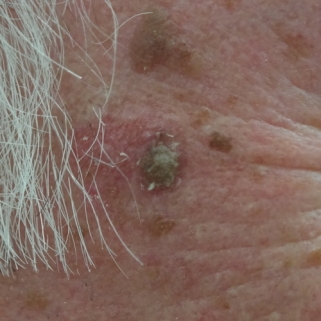Actinic keratosis – causes and treatment
Actinic Keratosis is a common precancerous lesion caused by sun exposure and damage from UV rays.
They are not usually immediately serious, but there is a small chance that they could be come cancerous, so it’s important to avoid further damage.
Dr Ross Perry, GP and founder of the London Mole Removal clinics, says:
“Actinic Keratosis are termed as precancerous lesions and are a result of sun damage causing collagen disruption and atypical growths.
“They are most commonly found in areas of sun exposure such as face and hands.
“Treated early, they are not a problem.”
It is important to recognise that actinic keratosis signal a higher risk of cancer.
The Skin Cancer Foundation advises:
“…if you already have an AK, you are likely to develop more actinic keratoses (plural) in the future. This puts you at a higher risk for skin cancer, since AKs can develop into squamous cell carcinoma (SCC), a common and sometimes invasive form of the disease.”
About 5-10% of actinic keratoses turn into skin cancer, although the vast majority of squamous cell carcinomas start off as actinic keratoses, which underlines the importance of taking early action.
Diagnosing Actinic Keratosis
Actinic keratoses look unusual, with a dry and scaly appearance:
- Flat or slightly raised
- Can look and feel rough, scaly or crusty
- May have a raised horn shape or bump
- Colour can vary, including shades of red, tan, pink, brown or silvery or just the same colour as the rest of the skin
- Size can vary from a tiny spot up to an inch across
- They may be completely painless, but can also feel raw, sensitive, painful, itchy, prickly or burning
- As well as face and hands, actinic keratosis can also appear on lips, ears, scalp, shoulders, neck and forearms – areas that tend to be most exposed to ultraviolet (UV) rays
Actinic Keratosis Treatment
After confirming correct diagnosis, doctors and surgeons can recommend the best means of removal. There are a number of options for treating actinic keratosis, including:
- Surgery – carefully and completely removing the lesions provides a permanent and effective result
- Laser treatment – destroying the spots and also stimulating the skin’s own healing and renewal processes, leaving skin clearer and healthier-looking
- Cryotherapy – Liquid nitrogen freezes the external tissue to destroy it. It will then crust and fall off, leaving healthy skin beneath
- Microcautery laser – intense heat device used to destroy the cysts
- Topical treatment – prescribed creams or ointments
Skin Blemish & Lesion Experts
The London Mole Removal Centre is a private company, offering private appointments checks and treatment for unwanted skin lesions, including moles, cysts, skin tags, warts, verruca, lipoma, xanthelasma, milia. The team are renowned for diagnosising adn treating the more unusual complaints and have a high level of exprtise. All consultations and treatments are carried out in person by doctors who are specially trained in the latest laser and skin surgery techniques and are highly experienced in the field.
Further advantages of private treatment at the London Mole Removal Centre include:
- No waiting lists
- Fully trained doctors, registered with GMC
- Moles can often be removed in the same appointment as the consultation, saving the need for a repeat visit and allowing patients to get their skin lesions removed very quickly
- Choice of 4 clinics in London and also Bristol
- Removed moles tested with report provided
For more information or to book a consultation, please complete the form on this web page or call 020 7731 3791.



